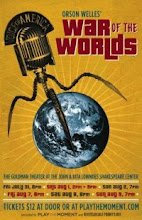"We annihilated the world before your ears." -Orson Welles
On October 30, 1938 twelve million people were sent into a state of panic when they started hearing live reports of a Martian invasion. Come relive the broadcast and see how millions fell into fear. This new production exposes the tricks behind the original radio cast by reliving it through the perspective of its listeners.
During last night's first rehearsal, the directors (Aradhana Tiwari and Joseph Fletcher) challenged the cast by asking open-ended questions such as: What is news? Why do we choose to believe in something? Why do we fall into fear so easily?
As the cast discussed the possible answers to these questions, we began to examine the many factors that play into the power of belief. There is that battle of knowledge vs. belief. Afterall, knowledge is useless if there are no believers. Additionally, timing is a key ingredient. Many Americans listening to the War of the Worlds broadcast thought the descriptions of martians were actually Germans. We also examined the expansion and transfer of energy. If chaotic and panicked energy spreads quickly around you, even the most reasonable person can be swept up in the ballyhoo.
What Orson Welles did, essentially, was change the way people think about the world around them in one short hour. He presented a new point of view. How did he do this?
Orson Welles played on people's fear of the unknown; he played on the naivete of the public. Mr. Welles, and his team of actors from the Mercury Theatre, spoke with conviction, which lead audiences to believe they were hearing news from trustworthy sources.
Additionally, the writer of the on-air dramatization, Howard Koch, (who based his radio script on author H.G. Wells' classic science-fiction novel "The War of the Worlds") carefully choose the language for his piece.
Mr. Koch utilized a cacophony of language and sound effects to instill fear into the minds of the listeners, enabling them to feel terrified and hopeless. Such words and phrases as: "fire", "explosion", "calamity", "charred bodies", "black smoke pouring in", "mysterious dark figures", "roads hopelessly jammed", and "everything wiped out" created uncertainty and horror. The sound effects of men screaming, helicopters spiraling downward, women and children yelling and crying, mumbling, and the ever-so-haunting sound of silence.
The diction used to describe the martians depicts an antichrist-like figure that rivals the descriptions used in the famous William Butler Yeats poem "The Second Coming." Details such as: "salivating monster", "large as a bear", "black eyes", "strange beings" and "men crushed under giant metal legs" create an image of an invincible adversary.
Beyond studying the words of the piece, the actors also worked with movement. Incorportating Anne Bogart's "Viewpoints" into the show will only help to further solidify the story, and help to meld both worlds together: the public and the Mercury theatre actors. As we moved through the space, we experimented with levels, behavioral gestures, duration, and sound. As we traveled around the small space, improvising and testing our comfort levels, we united at the end to create a beautiful image of the calm after the storm.
It is easy to scoff at the 1938 radio broadcast now (hindsight is always 20-20, isn't it?), and to scrutinize the errors of Mr. Koch's radio script. However, a similar hoax could again fool the public. Naturally, it would be a more difficult task now as we have many different news sources through the television, internet, and radio. Just remember what Mr. Welles said, "Don't drink everything that comes out of the tap."
By: Lindsay Cohen
Monday, July 6, 2009
Subscribe to:
Post Comments (Atom)


Nice post! Thanks for the behind the scenes look at your next play. Keep us posted on the dates, I don't want to miss this one.
ReplyDeleteI'd love to see video!
ReplyDeleteAppreciate the peek behind the curtain. Sounds like a do-not-miss event. ~Molly
ReplyDeleteVideo is up! Enjoy.
ReplyDelete